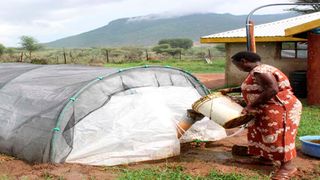
Christine Lolngojine feeds slurry into a biogas system at her home in Wamba, Samburu County.
| Nicholas Komu | Nation Media GroupSeeds of Gold
Premium
Troubleshooting various biogas unit problems
What you need to know:
- Once the biogas unit starts to operate, it is expected to supply gas as long as it is fed with slurry.
- Reduced feeding, blockage, unfavourable climate for gas production and moderate to minor leakage could lead to low gas output.
Many farmers across the country have made efforts to migrate to clean energy sources, in particular biogas.
However, they face various challenges that threaten to reverse this achievement. Top on these problems are units failing to work or malfunctioning every now and then and getting the technician comes with costs.
Knowing how to troubleshoot such problems will, therefore, lead to sustainable energy supply and increased adoption of the technology by farmers.
No gas after the plant has been in operation
Once the biogas unit starts to operate, it is expected to supply gas as long as it is fed with slurry. However, this may not happen and one of the things that leads to lack of gas at the use point are blockage of the cooker jets by water, dirt or rust. The burners should, therefore, be kept clean of dirt and rust.
Water vapour is one of the constituents of biogas. As the gas moves along the piping system, the vapour cools to form water and if there are no mechanisms of discharging the water, then it blocks the flow of gas at any point of the piping system. One way of reducing this problem is by installing the pipe at a proper gradient, from the digester to the usage point. The slope should ensure that the water flows back to the digester. Another option is to install water traps along the piping system.
There are several designs of water traps ranging from a bottle to specialised units. Some automatically empty themselves while others are manually emptied.
Another reason of failing to produce gas is that the unit has not been fed for a long time, which means that all the materials that were initially put have been digested and since no replenishment is taking place, then no more gas can be produced.
No gas could also mean that parameters that are important for biogas production have been interfered with. These include temperature, pH, presence of toxins and oxygen, scam layer formation and others. A major leakage along the system could also lead to unavailability of gas at the use point.
Reduced gas after the plant has been operating optimally
Reduced feeding, blockage, unfavourable climate for gas production and moderate to minor leakage could lead to low gas output. Examination of each of these issues will help you know the action to take and this might need a technician’s assistance.
Delayed/no gas production after the initial feeding
The plant can start producing gas within an hour or so after feeding or it might take a week depending on the status of the manure. In some cases, biogas system owners start storing manure once construction of the system starts and if the process takes some time, then the manure cures and once it is fed into the digester, it produces gas within a very short time.
However, if fresh dung is used for the initial feeding, then it takes some time before it produces gas. More than 75 per cent of the total gas available in organic matter is recovered in 20 to 25 days. This implies that within a week of feeding, the plant should start producing gas and any time after that could be taken as a delay.
Gas produced but not igniting
Biogas consists of methane, 50-80 percentage volume, carbon dioxide (20-50 per cent), hydrogen sulphide (0.01-0.4 per cent) and traces of ammonia, hydrogen, nitrogen and oxygen. For the biogas to burn, the methane level should be at least 50 per cent of the gasses produced. Initially, there is more carbon dioxide than methane since the digester traps some oxygen when the top is being sealed. Presence of oxygen leads to aerobic decomposition thus producing more carbon dioxide and water.
However, after the digester has been sealed and oxygen continues to be depleted, the methane level increases until the ignitable level is reached. If the initial gas is not burning up, then the best is to release it to the environment and try again latter after the pressure has built and repeat a number of times and if not successful after a number of trials, then you can call a technician





